Text
(Insight) Opportunities And Challenges To The Icelandair Buyout Of WOW Air

Experience The Skies reported that Icelandair formally purchased chief rival WOW Air (refer to post here) earlier. In the following insight, we will dig deeper into the opportunities and challenges as the new Icelandair Group competes with European and North American airlines for more passengers.
New Icelandair Group
The new Icelandair Group will be one of the biggest employers in Iceland. Before we discuss the opportunities and challenges for the group, here are some combined statistics based on the latest information published by Icelandair Group and WOW Air separately:
Workplace: ~5,300 employees
Current Fleet Size: 35 aircrafts (Boeing 737s - 3, Boeing 757s - 28, Boeing 767 - 4, Airbus A320/A321s - 17, Airbus A330s - 3)
Order Book: 18 aircrafts (Boeing 737s - 13 (see video below on the MAX), Boeing 787 - 1, Airbus A330s - 4)
Destinations Served: ~80 (including year round and seasonal operations)
Revenue: ~US$2.12 billion (up ~18% year to year)
Net Profit/Loss: ~US$15.66 million (down ~87% year to year)
While the majority (~77%) of the per merged Icelandair Group's income is from flight operations (passenger and cargo), it also earns revenue from its investments from other airlines, travel agency, hotel and other tourism ventures.
https://www.youtube.com/watch?v=E5Fn67ST2k8
Opportunities
There are four areas the combined Icelandair Group can find opportunities:
Route network refinements: Around 25% of their combined route network of 80 total destinations are overlapped. That means there may be some markets that can use a reduction in frequencies to support new routes. Timing on feeder flights to other European destinations can be reworked to maximize supply/demand and increase barrier of entry.
Headquarter functions: Some areas like information technology, human resources and procurement could be combined to build commonalities and efficiencies. This would reduce overhead costs.
Marketing and loyalty program integration: While the airlines will continue to operate as separate entities with different branding and products, some marketing efforts could be combined. For example, social media teams could join forces and build on their strengths on different platforms. Icelandair has a bigger presence on Instagram and YouTube while WOW Air is more popular on Facebook. The airlines can also explore opportunities to maximize choices for consumers by codesharing, link Saga frequent flyer programs to improve the value proposition on WOW Air flights, and streamline ancillary revenue generation options.
Airport support: Both airlines use Keflavík International Airport (KEF) as their home base, the new group can work with the airport authority to streamline processes with the goal to improve passenger processing, flow, and service offerings.
Challenges
Combining airlines always have its challenges. Typically, the new airline will face additional costs for 12-18 months as it evaluates and streamlines its entire operations. Management may face morale challenges over employment uncertainty and cultural differences in the short term.
Both airlines may have received incentives from airport authorities to start new flights, they are obligated to complete these terms before Icelandair Group can end any unprofitable routes. Any previous route announcements (such as to Vancouver International Airport (YVR) or Orlando International Airport (MCO)) could be delayed or shelfed which could impact passengers with a purchased ticket. Speaking of passengers, any route elimination may lead to higher ticket prices as supply and competition decreases and are not backfilled.
Icelandair and WOW Air's rapid expansion chiefly contributed to a 28.3% increase in passengers to Keflavík International Airport between 2016 to 2017. The airport added seven new gates in 2016 and had forecasted total passenger count to improve from 8.75 million to more than 14.5 million by 2025. As such, the airport authority created a master plan that would add significant number of gates and possibly a third runway within the new 7-10 years to accommodate this group. This masterplan may need to be re-examined now that there is only one airline group though likely wouldn't change as growth will likely to continue amid at a lower pace.
https://youtu.be/Q-c02-TavZw
Additionally, downstream supplies like tour agencies and hotel operators may experience smaller than forecast growth as the new airline pare down some unprofitable international routes in the near future.
About Larry Leung and Experience The Skies
Larry Leung is the Director of Research and Strategy at Experience The Skies. He is a certified avgeek, a public speaker and a dessert and design enthusiast. Contact him through LinkedIn, Twitter or email.
Experience The Skies is a consulting company based in Toronto, Canada that specializes in the travel industry with focus on the assessment, competitive analysis and development of loyalty programs, technologies, marketing, ancillary revenue solutions. Find out how Experience The Skies can assist in evaluating the entire customer journey from booking to the travel experience by contacting [email protected] or follow other posts on Twitter, Facebook, Flipboard, and Instagram.
Read the full article
#CHALLENGES#Icelandair#IcelandairGroup#KeflavikInternationalAirport#Marketing#OPPORTUNITIES#RouteNework#WOWAir
0 notes
Text
Icelandair Group Buys WOW Air
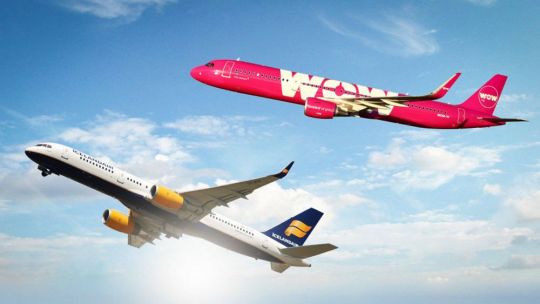
Icelandair Group purchased all the WOW Air shares in a transaction worth about kr$2.17 billion (~US$17 million) in a share exchange. The airline will also assume WOW Air's debts.
Icelandair and WOW Air Competition
Icelandair traced its roots back to 1937 and is the national airline of Iceland while WOW Air was the upstart that commenced operations starting 2011. Both have been aggressively competing over transatlantic and European traffic over the past 7 years with a low and ultra low cost model. While Icelandair has the bigger network of both airlines, WOW Air had introduced many overlapping destinations (nine North American airports alone - San Francisco (SFO), Toronto (YYZ), Chicago (ORD), Cleveland (CLE), New York (JFK), Boston (BOS), Orlando (MCO), Dallas-Fort Worth (DFW), and Washington DC (IAD)) by Summer 2018. The latter also scheduled to start a new service to Vancouver (YVR) in 2019. While both airlines combined are responsible for up to 4% of transatlantic traffic, the competition has been leading to lower fares and passenger yields.
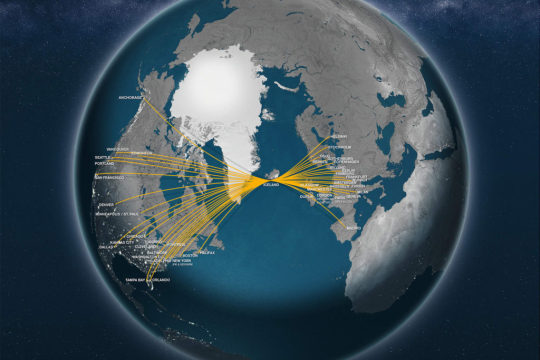
Icelandair Network (October 2018) (Information from Icelandair)
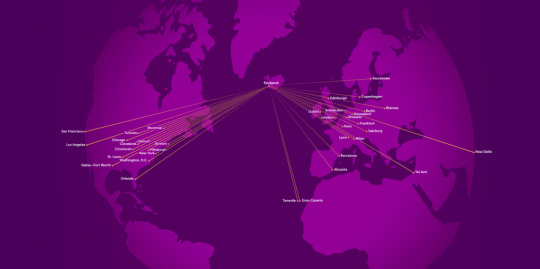
WOW Air network (October 2018) (Information from WOW Air)
Trouble Brewing For WOW Air
Owing to new route introductions, revenue continued to advance in double digit percentages during the fiscal year 2017-18. The heightened competition and higher cost base contributed the airline losing US$45 million before interest and taxes from July 2017 to June 2018. The airline failed to secure additional cash flow in a three-year bond issuance and finding a new investor to finance its transitions to a publicly traded company back in Summer 2018. As such, the airline entered into takeover talks with its chief rival Icelandair along with the Icelandic Competition Authority.
“WOW Air has built up a strong brand over the years, and accomplished a lot under that brand, to and from Iceland over the Atlantic Ocean,” acting director of Icelandair Group Bogi Nils Bogason said in a statement. “It’s a great opportunity for earnings, but the airline will continue to operate under its own initiative and under its own brand.”
Kúli Mogensen, the director and founder of WOW Air, said he was “very proud of our accomplishments and what we have built in recent years,” saying that the buyout represents a “new chapter” for the airline to grow and expand its reach.
What Is In The Future?
Icelandair, in a press release, stated that both airlines will continue to operate separate as different brands. Currently, the airline operates a fleet of 35 Boeing 737 (3), 757 (28) and 767 (4) aircrafts with an order book of another 14 aircrafts comprised of 737 (13) and 787 (1).
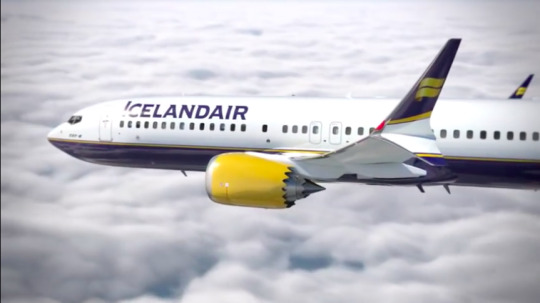
Icelandiar Boeing 737 MAX (Image from Icelandair)
WOW Air currently operates an all Airbus fleet of 20 aircrafts comprising of 3 A320s, 14 A321s and 3 A330s with another newer 4 A330s to be delivered this year. The scheduled delivery may be delayed as Icelandair evaluate operations.

WOW Air Airbus A320 (Imagine from WOW Air)
It is often challenging for airlines with a mixed fleet to merge into one operation as crew and pilots are not certified to operate the different aircraft types. For the time being, it is a good idea for Icelandair to continue flying both brands separately tackling the competitive market conditions while strategizing on next steps. In the meantime, their schedules should be coordinated to create a barrier of entry for other airlines. Additionally, the entire route network should be reviewed and overlapping poor-yield routes should be eliminated to improve overall finances of the new company. Experience The Skies has already seen WOW Air reduced routes to San Francisco (SFO), Cleveland (CLE) and Cincinnati (CVG) starting October 27, 2018.
About Larry Leung and Experience The Skies
Larry Leung is the Director of Research and Strategy at Experience The Skies. He is a certified avgeek, a public speaker and a dessert and design enthusiast. Contact him through LinkedIn, Twitter or email.
Experience The Skies is a consulting company based in Toronto, Canada that specializes in the travel industry with focus on the assessment, competitive analysis and development of loyalty programs, technologies, marketing, ancillary revenue solutions. Find out how Experience The Skies can assist in evaluating the entire customer journey from booking to the travel experience by contacting [email protected] or follow other posts on Twitter, Facebook, Flipboard, and Instagram.
Read the full article
0 notes
Text
Southwest Airlines Offers Complimentary In-Flight Movies Through Portal
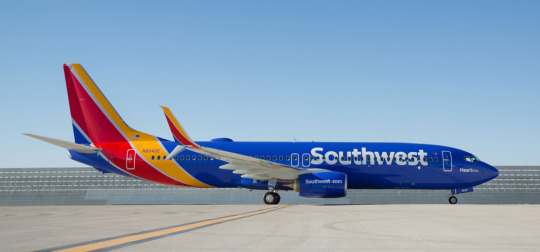
There is a perception that flying low cost airlines means a lack of inflight entertainment options on board. Southwest Airlines is breaking the rules by announcing that it will offer complimentary in-flight movies on board selected flights starting November 1, 2018. This is the third upgrade the airline introduced to improve the customer experience during flight this year.
Southwest Airlines
Dallas based Southwest Airlines operates the biggest domestic network in the world with over 4,000 weekday departures. It has a fleet of Boeing 737 aircrafts each equipped with an entertainment system on board which includes more than 30 first run and classic movies. The airline operated a pay-per-use model for these movies at US$5 each previously. This all changed on November 1, 2018 as the pay component was lifted.

Southwest Airlines offers complimentary in flight movies on all flights starting November 1, 2018 (Image courtesy of Southwest Airlines)
What Complimentary Entertainment Options Are Available?
Besides movies, customers already receive the following complimentary options on board most domestic and domestic portions of international flights:
Southwest mobile app and entertainment portal -
16 Live TV channels
On demand TV content
Flight tracker and destination city guides
Games
iHeartRadio® live streaming music and podcasts
Messaging with iMessage and Whatsapp (must download these applications in advance of departure)
The latter two items were added to the complimentary list in May and September this year.
Seatback pocket -
Southwest The Magazine
Additionally, customers can pay US$8 per device per day to gain Wi-Fi internet access when travelling on Southwest flights. Wi-Fi internet access will continue to be complimentary for the airline's Rapid Rewards® A-List Preferred members.
How Do Customers Access Entertainment On Board?
The Inflight Entertainment Portal is offered across the Southwest fleet on WiFi-enabled aircraft. Customers can access the onboard entertainment options through their own personal device (mobile, iPad, tablet, or laptop) by turning on 1. WiFi access, 2. connecting to the "SouthwestWiFi" SSID, and 3. navigating to www.Southwestwifi.com. It is not necessary to purchase WiFi in order to use the free inflight entertainment onboard. To maximize use of all entertainment options, customers should download the Southwest® mobile app. The iOS and Android versions can be found in the App Store and Google Play Store.
What Next?
While the airline has not announced additional details, it is continuing to explore new on board experience upgrades through the entertainment portal to be introduced in the future. In a future post, Experience The Skies will discuss how different airlines and airports use entertainment and other on board activities to ease customers' boredom while improving ancillary revenue streams.
About Larry Leung and Experience The Skies
Larry Leung is the Director of Research and Strategy at Experience The Skies. He is a certified avgeek, a public speaker and a dessert and design enthusiast. Contact him through LinkedIn, Twitter or email.
Experience The Skies is a consulting company based in Toronto, Canada that specializes in the travel industry with focus on the assessment, competitive analysis and development of loyalty programs, technologies, marketing, ancillary revenue solutions. Find out how Experience The Skies can assist in evaluating the entire customer journey from booking to the travel experience by contacting [email protected] or follow other posts on Twitter, Facebook, Flipboard, and Instagram.
Read the full article
#Complimentary#CustomerExperience#Free#InflightEntertainment#MobileApplication#Movies#SouthwestAirlines
1 note
·
View note
Text
British Airways Celebrated 60 Years Of Jetliner Service Across The Pond

October 4, 2018 marked 60 years since British Airways became the first airline in the world to operate jetliner service across the pond to New York City. Experience The Skies takes a look back on the historic event and how the London based airline battled with others in the race to claim this title.
British Airways
What Happened?
British Overseas Airways Corporation (BOAC), the forerunner to British Airways had a mission sixty years go. It wanted to be the first airline to fly a turbo jet engine aircraft between Europe and New York City. At the same time, Pan American World Airways headed by Juan Trippe, President, were in a tight race to bring a similar service with the new Boeing 707 aircraft.
While the de Havilland aircrafts had its fair share of technical challenges and crashes, BOAC was able to beat its American counterpart by three weeks with the launch of de Havilland Comet 4 aircrafts between London, United Kingdom and New York City, United States on October 4, 1958 just a few days after delivery. The airline flew two flights, one from New York to London and the other in reverse direction to begin commercial operations and officially brought on the "jet age".
The westbound flight had to make a fuel step in Gander, Newfoundland, Canada and completed the London to New York run in 10 hours, 22 minutes. The eastbound flight was able to take advantage of tailwind from the jet stream and completed the trip to London in a then record-breaking 6 hours, 11 minutes. This record was a major achievement for the aviation industry as a typical transatlantic flight between London and New York on propeller aircrafts would have taken up to 18 hours previously (this record was broken by British Airways' Concorde service in the 1970s).
While Pan Am made its first official commercial flight across the pond with the Boeing 707 on October 25, 1958, the airline's service and the aircraft's roominess (137 seats on the Boeing 707 vs 48 on the de Havilland Comet 4) proven to be an instant success. Over the course of operation, the Boeing 707 would be the more popular of the two and BOAC used them in the 19060s before both airlines transitioned to flying this route with other aircrafts such as the double decker Boeing 747.

British Airways celebrated being the first airline to use a jetliner on Europe to New York Service (Image courtesy of the airline)
One of the original cabin crew members, Peggy Thorne, 91, had joined BOAC in 1950 and was hand-picked to serve customers on the first flight. She remembered the first transatlantic flights as “marvellous”. “We were used to travelling to New York on Boeing Stratocruisers which took up to 20 hours. We couldn’t believe the flight was possible in such a short time.”
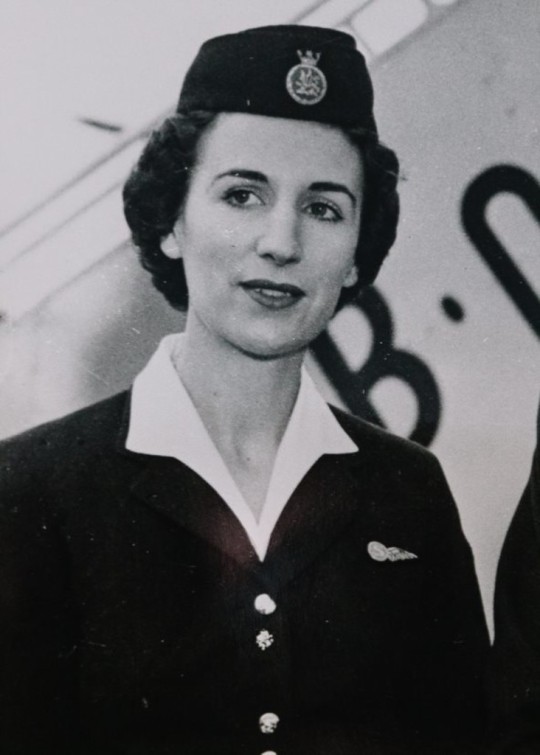
British Airways celebrated being the first airline to use a jetliner on Europe to New York Service - Peggy Thorne (Image courtesy of the airline)
While Pan Am is no longer in service, British Airways continues to be the leader in the London to New York market with up to 15 flights daily with oneworld partner American Airlines. The airline noted that a ticket to travel on the Comet "staggeringly cost the equivalent of £8,000 (~US$10,300). Today, a return flight costs far less - from £292 (~US$380)."
Even after 60 years, Peggy vividly recalled the inaugural: “It was so exciting to be the first – it was wonderful. There were all sorts of dignitaries on board, press and the chairman of BOAC. It was a thrilling experience. We served customers Madeira biscuits and coffee when they came on board, followed by cocktails and canapes, and then a five-course lunch with wines. Petit Fours followed and then there was Afternoon Tea! Our customers loved it – they ate and drank from when they got on board until the time they got off.”
Peggy was also invited to see how the airline now trains its cabin crew members: “It’s overwhelming. The technology and the number of aircraft training cabins - we had nothing like this in our day.”
When Is The Celebration?
While British Airways has no official plans to celebrate this milestone, it is in the mist of planning its Centenary next year. Alex Cruz, British Airways Chief Executive and Chairman, paid tribute to the crew of the first flights: “British Airways and its predecessors have always pioneered innovation and hospitality and this is a great early example. Next year we celebrate 100 years of taking Britain to the world and bringing the world to Britain, and the quality of service we provide to customers is better than ever.”
About Larry Leung and Experience The Skies
Larry Leung is the Director of Research and Strategy at Experience The Skies. He is a certified avgeek, a public speaker and a dessert and design enthusiast. Contact him through LinkedIn, Twitter or email.
Experience The Skies is a consulting company based in Toronto, Canada that specializes in the travel industry with focus on the assessment, competitive analysis and development of loyalty programs, technologies, marketing, ancillary revenue solutions. Find out how Experience The Skies can assist in evaluating the entire customer journey from booking to the travel experience by contacting [email protected] or follow other posts on Twitter, Facebook, Flipboard, and Instagram.
Read the full article
#BOAC#Boeing707#BritishAirways#BritishOverseasAirwaysCorporation#deHavillandComet4#PanAmericanWorldAirways
0 notes
Text
KLM Improves Customer Experience By Taking Lead In Augmented Reality
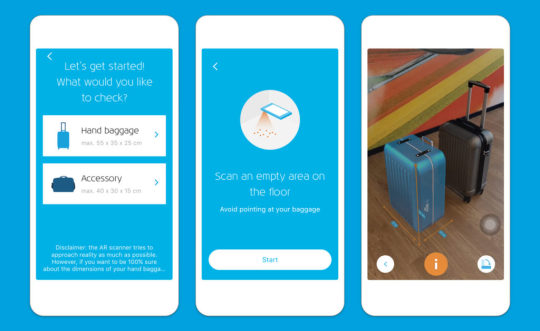
Augmented reality has been slowly evolving from cutting edge technology to every day life savers in the past two years. Both Apple (see post) and Google (see post) announced big plans on incorporating augmented reality elements into their iOS and Android mobile operating systems for the past two years. KLM, known for the building customer facing technologies is one of the first in the world to use augmented reality to assist customers measure their carry on baggages for compliance. Experience The Skies takes a look at how it works.
KLM and Augmented Reality
What Is It?
Augmented Reality is an interactive experience of a real-world environment whereby the objects that reside in the real-world are "augmented" by computer-generated perceptual information including visual, auditory, haptic elements from sometimes across multiple devices. Apple and Google's implementation of this technology has been applied to three main scenarios: Play, Learn and Life. Play has the most success out of three so far with the popularity of games like Pokémon Go. For travel experiences, the best use case has been wayfinding where customers are able to follow the instructions on their phones to locate gates, restaurants, etc.

Augmented reality used for travel (Picture from Apple and American Airlines)
KLM's New Idea
First introduced in the latest version of the KLM mobile application on the iOS platform, customers with the right mobile devices can virtually measure their carry on baggages for size prior to departure to the airport. This will significantly reduce the probability of these baggages not meeting the specific guidelines set out by the Dutch airline which will require gate check to the final destination. Instructions are very simple to follow and can be completed within three steps by using the back camera as the measuring tool.
https://youtu.be/LAvRIFN_hNc
In the rollout, Pieter Groeneveld, Senior Vice President Digital Air France - KLM said that “By harnessing the potential of AR, KLM is taking the next step in terms of digital service provision. With the AR hand baggage check, passengers can now see at a glance whether their hand baggage is the correct size. By offering this service, we are placing the needs of our customers first. We also continue to be pioneers of innovation in our passengers’ best interests."
Analysis
The use of augmented reality to measure full size carry on baggages in real time allows KLM to improve customer experience by lowering their anxiety and fees associated with checked bags at the airport due to irregular sizes and reducing wait time in lineups at the airport. For airline agent, this implementation improves productivity by reducing bottlenecks created by checking these bags at the airport. This enables agents to assist customers with more complicated travel matters.
Besides virtual baggage measurement, KLM has also implemented augmented reality to display its Boeing Dreamliner aircraft in 360-degrees. Additionally, the airline showcased the story of Anthony Fokker's House 98 with the technology in its own KLM Houses App.
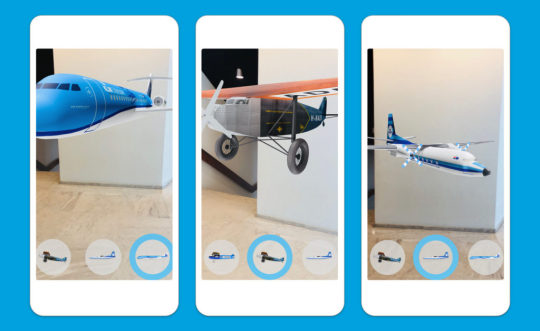
KLM aircrafts in augmented reality (Picture provided by KLM)
Just The Beginning
KLM has been able to use augmented reality to engagement customers' imagination, reduces their travel anxiety with a new measuring tool and improve airport agents' productivity. This is just the beginning as airlines around the world find new use cases to implement augmented reality through out the travel journey. If implemented successfully, this technology can enhance travel through engagement with unique experiences and create new ancillary revenue streams for airlines in partnership with airports and third party vendors. Find out more about these tailored use cases and opportunities by contacting Experience The Skies.
About Larry Leung and Experience The Skies
Larry Leung is the Director of Research and Strategy at Experience The Skies. He is a certified avgeek, a public speaker and a dessert and design enthusiast. Contact him through LinkedIn or Twitter.
Experience The Skies is a consulting company based in Toronto, Canada that specializes in the travel industry with focus on the assessment, competitive analysis and development of loyalty programs, technologies, marketing, ancillary revenue solutions. Follow Experience The Skies on Twitter, Facebook, Flipboard, and Instagram.
Read the full article
0 notes
Text
Air Canada Ups Antes With Signature Service On Selected Flights (Part 1)
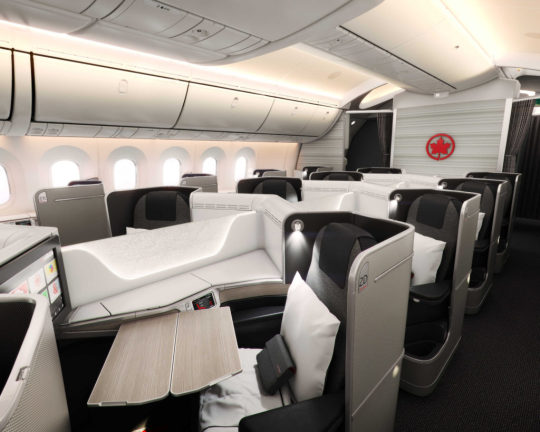
Air Canada enhanced its business class product with the new Air Canada Signature Service. The enhancement is available immediately for international travellers while introduced on selected transcontinental flights from June 1, 2018. In a North American first, the airline also announced a valet service for selective full price business class passengers in late 2018. Find out the details below and the impacts it will have with its competitors.
Air Canada
Air Canada currently operates to 64 airports in Canada, 60 in the United States and 98 in Europe, the Middle East, Africa, Asia, Australia, the Caribbean, Mexico, Central America and South America. In its announcement, the Montreal based airline brought the seamless premium experience introduced for its Toronto-Pearson (YYZ) to Vancouver (YVR) flights to the following markets:
Starting today: All international flights
Starting June 1: At least 12 transcontinental flights within North American operated by Boeing 767, 777, 787 and Airbus A330 aircrafts furnished with lie flat beds with have this new service. The city pairs and their frequencies (based on Summer 2018 schedule) include:
Toronto-Pearson (YYZ) to Vancouver (YVR) , San Francisco (SFO) , and Los Angeles (LAX)
Vancouver (YVR) to Montreal (YUL) and Newark (EWR)
Three overnight red-eye flights will be served by the latest wide-body aircrafts. These flights used to be served by smaller Boeing 767s or Airbus A320s.
Flight
Departs
Arrives
Aircraft
AC126
Vancouver 22:35
Toronto 05:55 + 1 day
Boeing 777
AC788
Los Angeles 22:15
Toronto 05:52 + 1 day
Boeing 787
AC754
San Francisco 22:45
Toronto 06:37 + 1 day
Boeing 787
Air Canada Signature Service
North America Transcontinental
The premise of the enhanced Air Canada Signature Service is to provide a seamless travel experience for a customer travelling in business class. Qualified North American will have a consistent service including:
At the Airport
Expedited check-in at the airport with designated counters
Priority security clearance
Priority baggage handling and additional allowance
Access to concierge services at Toronto-Pearson, Montreal and Vancouver airports on the day of departure for tickets in fare class J, C, D, Z, P
Access to the Air Canada Maple Leaf Lounge
Priority boarding (Zone 1)
On Board
New generation business class seat that can convert to lie-flat beds, AVOD in-flight entertainment system with a minimum of 15" High Definition screens, A/C Power and USB port
Updated onboard menu items from chef David Hawksworth, including for the first time on flights serving lunch and complemented by an expanded wine selection chosen by Air Canada sommelier Véronique Rivest
New restaurant style dishware and glassware will be used on board
New Air Canada Signature Cocktail
https://www.youtube.com/watch?v=u2rNE6usvDQ
International
Besides the benefits highlighted for the North American market, eligible international business class travellers will enjoy additional services including:
At the Airport
Access to Air Canada Signature Suite in Toronto-Pearson, featuring à la carte restaurant dining from a menu created chef David Hawksworth along with a selection of Moet & Chandon champagne, wines and premium cocktails
Access to concierge service at the select airports including (availability may vary based on fare and departure location):
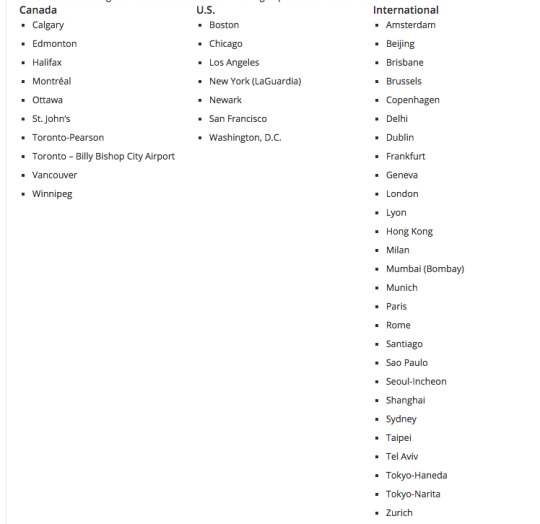
Concierge Service Locations (Date provided by Air Canada)
On Board
Enhanced wine, spirits and Laurent-Perrier champagne
Espresso and cappuccino served with dessert or a new cheese selection
New amenity kits by Want Les Essentiels, with premium care products by vitruvi
the South Asian flights to Mumbai (BOM) and New Delhi (DEL) will feature menu created by chef Vikram Vij
https://www.youtube.com/watch?v=fqAqrPVghnY&t=2s
Air Canada Valet Service
Starting in late 2018, Air Canada partnered with BMW Canada to offer customized valet sedan service for full fare business class customers. To qualify, the customer has to be originating in Toronto (YYZ) or arriving at the airport originating from a domestic flight with onward international travel. This would be especially useful for those customers with tight onward connections.

Valet Service at Toronto Pearson International Airport (Photo from Air Canada)
Benjamin Smith, President of Passenger Airlines said on the new service that "Our new Air Canada Signature Service and Air Canada Signature Class brands reflect the ongoing refinements to our premium travel service. We know our premium customers travelling on longer flight itineraries place a high value on convenience and comfort when in airports or onboard an aircraft, and with Air Canada Signature Service we provide a level of service unsurpassed in North America on every widebody flight."
Impact
Air Canada is the first in the region to introduce a consistent premium product and service for North American transcontinental and international routes flown by widebody aircrafts. This is important as 46% of its 2017 revenue was derived from international passengers (up 3% from 2015). A significant number of them connect onward from the airline's key hub airports in Toronto-Pearson, Montreal and Vancouver or from Newark, San Francisco and Los Angeles where Star Alliance members have a big presence.
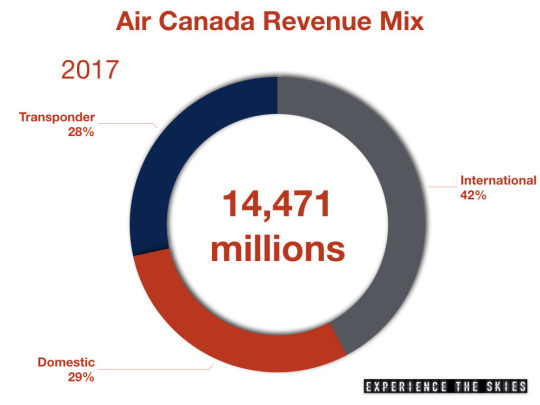
Revenue Mix By Passenger Group (2017) (Data from Air Canada)
In the domestic market, the airline is marketing this new service in advance of WestJet's new international product to be introduced in late 2018/early 2019. Promoting a seamless high quality service with more flight connections may sway enough customers to pay higher prices and to stick with the airline over using a potentially lower priced but unproven new product with a more point-to-point operation.
In the international scene, Air Canada is the highest ranked North American airline at no.29 on Skytrax's 2017 list and is the only one with a 4-star rating. While its brand value continues to improve (in a recent Brand Finance study, the airline moves up from 21st to 15th in 2017), there is room to grow as the airline expands further into secondary European, African and Australian destinations. While the new service may not be revolutionary, it provides the airline new opportunities for its marketing department to use the rebrand to engage and build awareness to a wider audience. As of this post's published date, a search of "Air Canada Signature Service) on Google generated almost 5,000 results and 500 news stories within one day of the announcement. It was also one of the more talked about topic on popular travel forums and blogs.
In the next installation, we will discuss strategies on how Air Canada can further differentiate itself from other airlines using this new service as a launching point.
Read the full article
#AirCanada#AirCanadaSignatureService#AirCanadaValetService#Businessclass#ConciergeService#International#Transcontinental
0 notes
Text
What Are The World's Busiest Routes For 4 Billion Passengers?
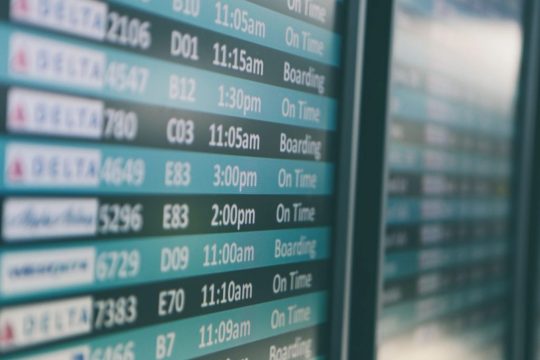
2017 was another successful year for the travel industry as near 4 billion people flew to different locations around the world. With this many trips flown, have you ever wondered which routes are the busiest in the world? OAG has the world's largest network of air travel data and provided us a list of the busiest routes across domestic and international markets. In this post, Experience The Skies explores the details and look for marketing opportunities.
Busiest Routes
Introduction
IATA published key metrics for 2017 which indicated that RPK, ASK and load factors all improved around the world.
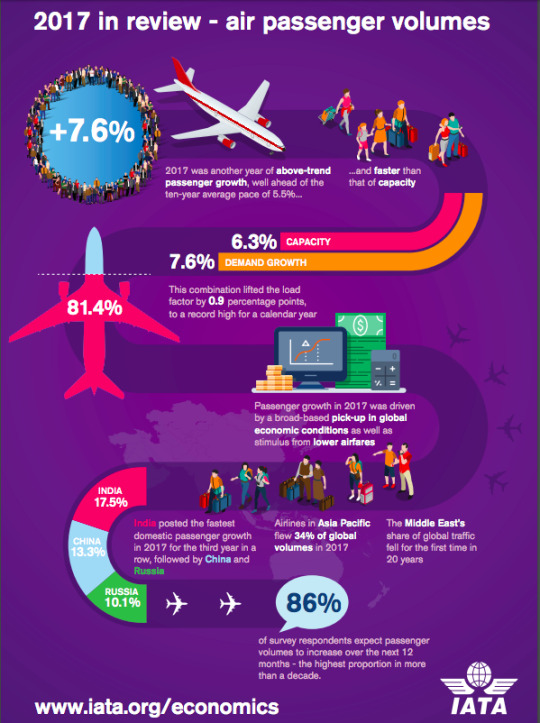
IATA 2017 In Review (Infographic from IATA)
Domestic
The busiest domestic route continues to be the 282 mile (451 kilometer) tripper between the South Korean capital Seoul's Gimpo International Airport (GMP) and the resorts based Jeju Island's Jeju International Airport (CJU). With almost 65,000 flights yearly, this route pair averages more than 178 flights daily.

Busiest Domestic Route in 2017 (Infographic created by Experience The Skies, Data collected from OAG)
Other route pairs in the top 3 include:
Melbourne (MEL) to Sydney (SYD) in Australia with 54,519 flights in 2017 (average: 149 flights daily)
Mumbai (BOM) to New Delhi (DEL), India with 47,462 flights in 2017 (average: 130 flights daily)
International
Internationally, the flight pair between Hong Kong International Airport (HKG) in China and Taiwan Taoyuan International Airport (TPE) in Taiwan continues to lead with more than 29,000 flights annually.
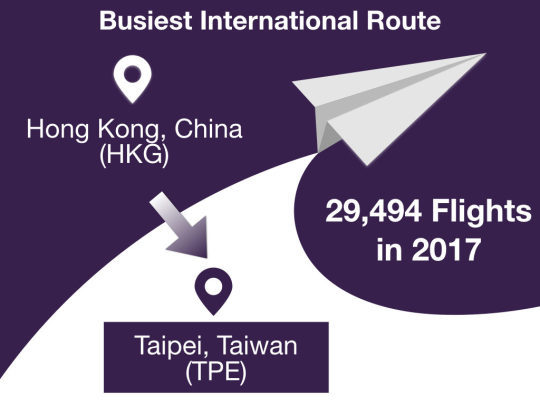
Busiest International Route in 2017 (Infographic created by Experience The Skies)
No.2 and 3 are also within Asia:
Kuala Lumpur (KUL), Malaysia to Singapore (SIN), Singapore with 29,383 flights in 2017 (average: 80 flights daily)
Jakarta (CGK), Indonesia to Singapore (SIN), Singapore with 26,872 flights in 2017 (average: 73 flights daily)
Other Route Tidbits
Outside of Asia and Australia, the busiest routes in other continents include:
North America (Domestic) - Los Angeles (LAX) to San Francisco (SFO), USA with 34,897 flights in 2017 (average: 95 flights daily)
North America (International) - New York City (LGA), USA to Toronto (YYZ) with 17,116 flights in 2017 (average: 46 flights daily)
Europe (Domestic) - London (LHR), UK to Dublin (DUB), Ireland with 14,556 flights in 2017 (average: 39 flights daily)
Europe (International) - London (LHR), UK to New York City (JFK), USA with 14,218 flights in 2017 (average: 38 flights daily) (Refer to Insight on this flight pair)
South America - Bogota (BOG) to Cali (CLO), Columbia Brazil with 21,792 flights in 2017 (average: 59 flights daily)
Africa - Cape Town (CPT) to Johannesburg (JNB), South Africa with 31,914 flights in 2017 (average: 87 flights daily)
Marketing
Airlines add frequencies to a specific flight pair based on by demand from business and leisure travels. The ones on this list typically possess both groups of travellers with demand that is consistent throughout the year. Travel within Asia continues to lead higher than average growth rates in 2017 with China and India expanding both domestic and international operations at a rapid pace.
Domestic
In all major continents (Asia, Africa, Europe, North America, South America and Australia), traditional network carriers are defending market shares with higher volume of low cost (LCC) and ultra low cost carrier (ULCC) competition in their domestic markets. The latter carriers are marketing to potential passengers with attractive base fare options with no advanced seat selection, hand carry on baggage only and lack of other amenities such as status miles, upgrade opportunities, or food. Some network carriers such as All Nippon Airways introduced their own low cost carriers (Peach Aviation and Vanilla Air) to create a bigger marketplace and defend overall market for the airline group.
International
With the introduction of newer generation of Boeing 737/777/787 and Airbus A320, A350 and A380 family aircrafts, airlines have been able to expand their route network in both distance and capacity. Traditional network airlines are starting to see more competition from LCCs and ULCCs entering the Trans-Atlantic (TATL) and Trans-Pacific (TPAC) market place with the likes of WOW Air, Norwegian, LEVEL, Joon, Air Asia, Hong Kong Airlines starting or expanding operations. These carriers use the same no frill marketing approach to entice potential customers to consider them on their next journey. Network carriers like British Airways, Delta Air Lines, KLM, Air France, and American Airlines are also introducing this same type of no frill fare to capture this segment of population.
In the next post, we look into the future of air travel. Are the terms leisure and business enough to capture wants and needs for both domestic and international travel? How should different sets of travellers be marketed to?
Read the full article
#AllNipponAirways#AmericanAirlines#BritishAirways#BusiestRoute#busiestroutes#Domestic#HongKong#International#JejuIsland#Seoul#Taipei#Travel
0 notes
Text
Movies And Airlines - Strategies To Engage Customers And Drive New Revenue
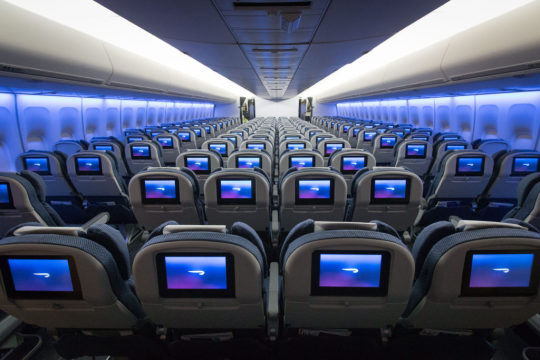
The 90th Academy Awards ceremony were held on March 4, 2018 at the Kodak Theater in Los Angeles, USA. The "Oscars", as they are more commonly know, is the climax of the season and sets the stage for The Academy of Motion Picture Arts and Sciences to celebrate the best in cinema over the past year. From the beginning, movies have played an important role in providing entertainment choices for passengers on board an aircraft. Find out more about their relationship and how studios can partner with airlines more strategically to engage and drive higher sales for both.
Movies and Airlines - Past and Present
The first movie shown on board was in 1921 in Chicago's Parade of Progress Exposition. Attendees were whisked upwards 2,000 feet (roughly 610 meters) on an amphibious airplane operated by Aeromarine Airways for a showing of "Howdy Chicago".

First In-Flight Screened Movie (Source: Motion Picture News, Inc.; photograph likely to be from Rothacker Film Company, which staged the screening - Motion Picture News, August 27, 1921 (page 1070))
Four years later, the first commercial in-flight movie was shown on a flight between London (Croydon Airport) and Paris (Orly Airport). Imperial Airways (pre-cursor to British Airways) screened "The Lost World" on board a de Havilland DH.34 in April 1925. It was a significant event at the time as the silent movie about an ape-man and dinosaurs found at an expedition was only released two months prior in the United States.
https://upload.wikimedia.org/wikipedia/commons/2/2e/The_Lost_World_%281925%29.webm
The 1920s paved way to overhead projectors, laserdiscs and video cassette players in the 1970s and 80s. While display technologies evolved over 60+ years, movie delivery being controlled by the airline did not change until 1988. That was the time when the Airvision company introduced the world's first in seat audio video on demand (AVOD) system using 2.7 inches (roughly 69mm) sized LCD screens in a trial on board Northwest Airlines (now part of Delta Air Lines)'s fleet of Boeing 747 aircrafts. The positive customer response began a move to this technology across the entire airline industry.
While AVOD technology on seat back screen still dominates the marketplace as the main delivery choice of in-flight entertainment for major network carriers' international operations, it is slowly being replaced by streaming via an airline's mobile application on personal devices (e.g. phone or tablet) or laptops within the domestic or regional operations. Movies are also competing with customers' own media contents (e.g. offline Netflix downloads), live tv and Wi-fi internet connection (which allows for external video streaming sources like Vimeo and YouTube).
Movies and Airlines - Future
Movies will continue to play a major role in entertaining customers for flights longer than 2.5 hours with seat back screen options are referred over other options for flights great than 5.5 hours. The latter may be dictated by power sources (e.g. USB or AC Power) provided by airlines and tolerance for watching the movie by holding the device at an angle for a prolong period of time.
First rate movies are important to attract customers. Airlines spend upwards to US$20 million or more for movie rights that allow them to screen them for a period of time. Many work with content supplier like Golden Eagle in obtaining rights for movies that are still in theatre and have not been made available on streaming services or for sale on DVD/Blu-ray.
British Airways introduced the Award Worthy category to showcase movies that received nominations or won awards at this year's BAFTA or the Oscars. Other airlines also publish monthly lists showcasing the entertainment choices for the month and into the future.

British Airways
The goal in both instances is to draw more customer attention for higher viewerships. But is that enough? What do airlines or movie studios get out of viewerships? We will explore that in the next post.
Read the full article
0 notes
Text
Star Alliance Partners With Accenture On Customer Digital Platform

Star Alliance partners with consulting firm Accenture to develop and implement the Digital Services Platform (DSP) with the goal to improve customer experience through consolidating digital and mobile services offered across all 28 airline members.
Star Alliance
How Does DSP Work?
The DSP is a platform that establishes common data fields, interfaces and allows for data from multiple sources (from member airlines to third-party vendors) to be consolidated and available to all members. Some key benefits for having a common digital platform in the short run includes the ability for all member airlines to:
Display similar flight or aircraft information (e.g. flight details, ticketing data, cabin information, ancillary products)
Interact and share information more seamlessly with passengers (e.g. baggage tracking, seat selection, special meal ordering) and third party vendors (e.g. catering, services)
Start and modify new transactions (e.g. easier to take over a passenger's record during service disruptions)
Develop, implement and maintain data systems and software
"Most frequent travellers have a 'home airline' in our network and would prefer to control their entire travel experience through a single app or website," said Star Alliance CEO Jeffrey Goh. "We are therefore working to create central capabilities that can be shared for use by our individual members."
Further Robert Zippel, leader of the technology consulting within Accenture's Travel industry practice, "A seamless travel experience for airline customers depends on an airline's ability to participate in a broader travel ecosystem spanning the whole spectrum of the aviation, travel and tourism industry. Airlines need to embrace collaboration with their alliance member carriers and associated ecosystems to orchestrate a greater understanding of a traveller's fast-changing requirements. By offering real-time data exchange and standardised applications to improve a customer's travel experience for multiple carrier journeys and beyond, the Star Alliance DSP is a great example of a system that enables this kind of collaboration."
DSP Use Case #1 - Seat Selection
Old Process
Seat selection has always been a program with an itinerary across two or more Star Alliance member airlines. Previously, a customer purchasing a ticket travelling on two or more Star Alliance airlines may result in the option of picking seats only in the ticketing airline. The customer would have to contact the ticketing airline to obtain flight locater codes for the other flights and contact the other airlines separately to reserve seats. Any changes to seat assignments might not be notified by any of the airlines and the customer would not be able to make further changes online. *The passenger can wait to receive a seat assignment during airport check in or at transfer points but might lose out on obtaining a more desirable seat location.
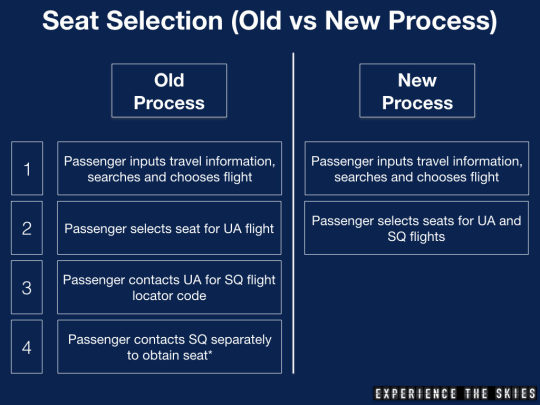
Star Alliance Seat Selection Old vs New
New Process
Starting on February 2, 2018, United Airlines customers would be the first through the DSP technology to receiving seating map view for flights operated by Singapore Airlines. Based on the fare type purchased, customers would be able to select seat in advance directly on united.com or the United app. This improves flow and reduce time to search and select seats exponentially.
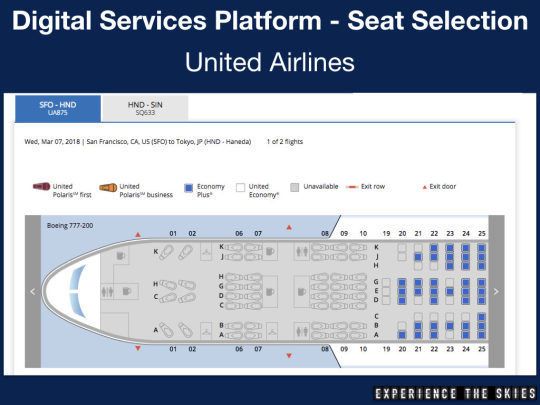
Star Alliance - Advance seat selection in one transaction (United Airlines and Singapore Airlines)
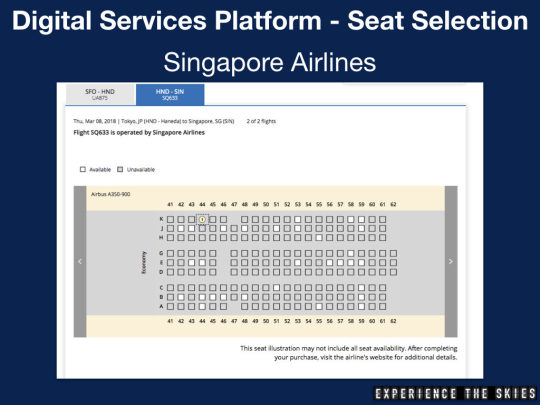
Star Alliance - Advance seat selection in one transaction (United Airlines and Singapore Airlines)
DSP Use Case #2 - Baggage Tracking
Lufthansa will be using the DSP technology for real time baggage tracking across journeys with flights on Star Alliance. The data would be provided to the Star Alliance Baggage Hub. In operation since 2016, all member airlines would have access to collect and display relevant baggage information to the customers. This would enable them to track their baggages across the entire journey using their tag information.
Future Use Cases
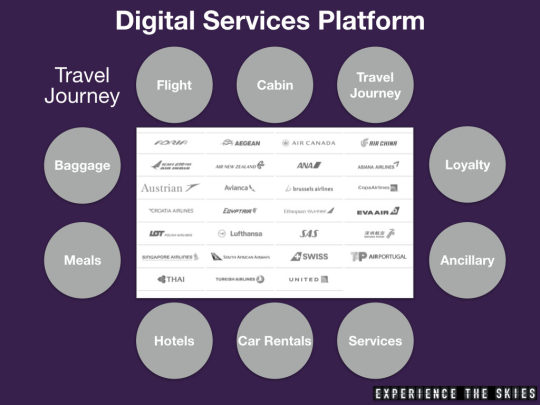
Star Alliance DSP Use Cases
Seat selection and baggage tracking are just two use cases available using the DSP technology. Experience The Skies curated other use cases for Star Alliance / Accenture to consider:
Airport Management - Star Alliance would be able to reduce physical footprint by increasing self-service offering such as self-check in at departure hall/transit point, security lane management and gate boarding. Standardizing check in procedures allows the alliance to visit how it measures minimum connection time between airlines in different airports. This will ensure that customers would be able to make their connections with ease.
Loyalty - Customers would be able to track and claim missing flight mileage faster and member airlines would be able to audit flights taken more efficiently in the short run. By the end of 2018, customers would be able to redeem awards across all 28 Star Alliance member airlines with ease. Long term goals would be to standardize redemption products (such as premium economy mapping), introduce easier flight upgrades using miles, and creating unique loyalty based marketing, contests and retailing experiences.
Ancillary products and services - Customers would be able to select from a list of standardized ancillary products and services (such as priority security, boarding, upgrades, accessibility needs and dietary meal selection) across all the Star Alliance member airlines. The latter is important to provide assurance that customers with dietary restrictions will be accommodated.
Third party partnerships - Star Alliance is the only one to provide its Gold members a complimentary upgrade to first class on board Heathrow Express. With DSP technology, it would be easy to work with the train operator to add the segments directly to the plane ticket. Other vendors such as hotels, car service and spas or different transportation modes (e.g. train and cruise connections) can also be considered for addition. The key is to make the travel itinerary as seamless as possible. Based on the data collected from different travellers, member airlines would be able to create better marketing and retail opportunities through personalization.
Read the full article
0 notes
Text
Apple iOS 11 Business Chat Disrupts Communication

At a special WWDC session on back in June 2017, Apple Inc. unveiled Business Chat within the Messages application. The new feature was officially rolled out in a beta release in early 2018. Experience The Skies takes a quick look at this new feature and highlight its key benefits / drawbacks.
Apple iOS 11
Recently we posted a couple of insights on how Apple 2017's software and hardware (Insight) and hidden iOS 11 features (Insight) that will enhance traveller experience. We will use this new instalment to highlight the new Business Chat feature that could disrupt the way travellers and businesses would interact with in the future.
Messages
Messages is a default communication application in the iOS ecosystem and has been in place since the iPhone's introduction almost ten years ago. It evolved from a simple SMS tool to a full on interaction platform with its own app store that includes applications, stickers, and games. In an earlier iOS 11 insight, we highlighted a new feature that allows users to transfer cash or send gift cards.
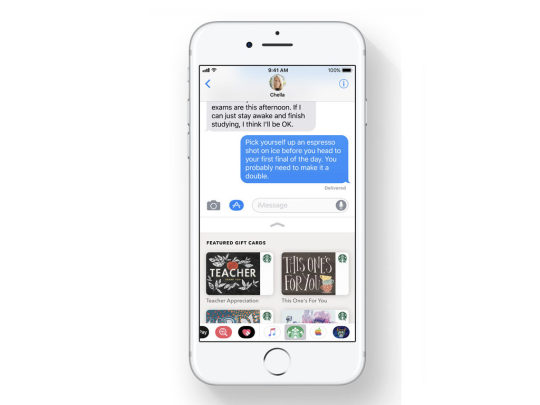
Apple 2017 WWDC iOS 11 - Messages Application ( Source: Apple Inc.)
Business Chat - How It Works
While the use case above describes personal interactions, the new Business Chat feature extends the concept by allowing businesses to interact with customers directly inside the Messages application. This method of communication enables users to quickly engage a live person or a bot for answers to questions, resolve issues or complete transactions using the iPhone, iPad or Apple Watch.
iOS 11.3 beta 1 released on January 25, 2018 is the first to include the Business Chat feature. The release included instructions on how companies can set up their in house or off the shelf chat applications* to build an interface that can receive and send communications (with attachments and rich content).
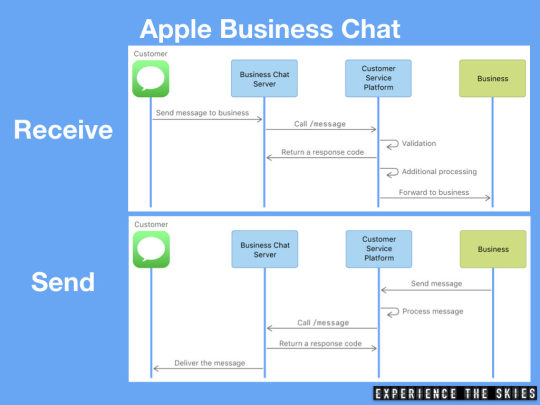
Apple Business Chat Receive and Sent Functions (Source: Apple Inc.)
*LivePerson, Rocket.Chat, Genesys, Nuance and Saleforce Service Cloud are some of the off the shelf Customer Support Platform (CSP) vendors that will work with Business Chat. In particular, Genesys is noted for counting airlines - Emirates, Air Transat and reservation giant - Sabre as clients.
There will be additional integration with the following iOS stock applications at start:
Apple Pay - one touch payment using Touch ID or Face ID
Calendar - appointment scheduling, shipment tracking, notification
Maps - wayfinding, location data
In the following example, a passenger is interacting with an airline to change a seat for a flight from SFO-LAX. Payment would be collected as required in real time and the passenger's itinerary would be automatically updated within the Calendar and airline's own application.
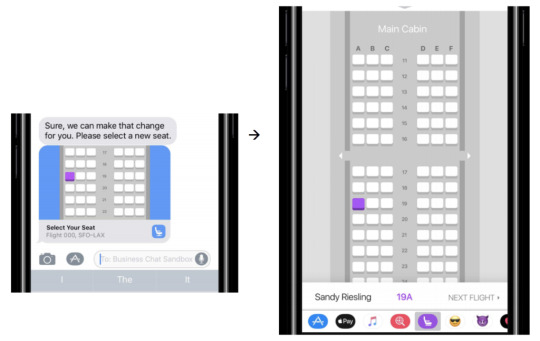
Business Chat Airline Seat Allocation Example (Source: Apple Inc.)
Benefits and Drawbacks
Benefits
Business Chat will bring a new way of interaction between C2Bs and B2Bs. Here are five key benefits:
1. Efficiency - Response may be instantaneous and overall interaction time can be reduced dramatically when compared with phone inquiries. Users would not have to encounter voicemails, long waits on the phone, following email chains or search through a website just to get simple questions answered. Timeliness in receiving responses or resolving issues generally plays a large role in customer satisfaction scores. The instant response feel can improve that expectation.
2. Familiarity - while many businesses use an automated phone system to guide users through many troubleshoot options, it may sound unfamiliar, unclear and requires a clear phone connection. This is especially problematic when there are too many options or the language used by the automated system is not the same one used by the user.
3. Personal - Users sent billions of messages annually and have a natural feel communicating this way. Business chat aims to generate the same personal feel to users.
4. Monitoring and Improvement - companies can use the interactions to build trend analysis and find out common complaints that may require a change in process.
5. Staff Training - with Business Chat, many canned questions could be answered by a bot. Businesses could spend its resources on training staff to respond to higher priority issues or managing more complex inquiries.
Drawbacks
The major drawback of Business Chat is the proprietary nature of the Messages application which shuts out all other mobile operating system or chat application access to the API. This will limit access to electronic devices on the iOS platform initially. Similar to iTunes, Apple might chose to publish the application in other systems in the near future to gain wider user engagement.
Update
iOS 11.3 beta 2 and 3 released on February 6 and February 21 respectively did not include new functionalities or significant bug fixes to Business Chat. It is expected that three more beta releases will be issued and the final release will be rolled out to eligible iOS users in April 2018. We will continue to update this post with new information on releases.
In the next part of the series, we will key competitors to Business Chat and how the travel industry has embraced them so far.
Read the full article
0 notes
Text
Blockchain And The Airline Industry (Part 2)
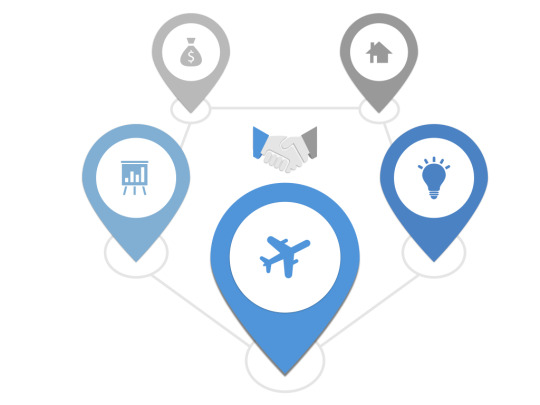
In the first part of this series, Experience The Skies introduces the blockchain concept and some of the early adapters to the technology. The second part will be focused on business use cases and determine some of the obstacles facing the airline and travel industry at large.
The Airline Connection
Settlements
The travel industry records billions of transactions annually. Take airlines, for example, the International Air Transport Association (IATA)'s clearing house alone managed more than US$55 billion of settlements from 430 participants. Similarly, its financial systems handled over US$400 billion yearly with about US$7.7 billion (~2%) being bank fees. The latter figure is substantial when compared to the industry's profit of US$34.8 billion in 2016.
Blockchain technology can process settlements between airlines in the distributed ledger (i.e. the network) with higher efficiencies, better transparency and lower duplicates. Since each transaction would be validated, there would be less disputes. With travel industry margins being thinner than others, a cost reduction owing to bank fee eliminations could yield a better bottomline.
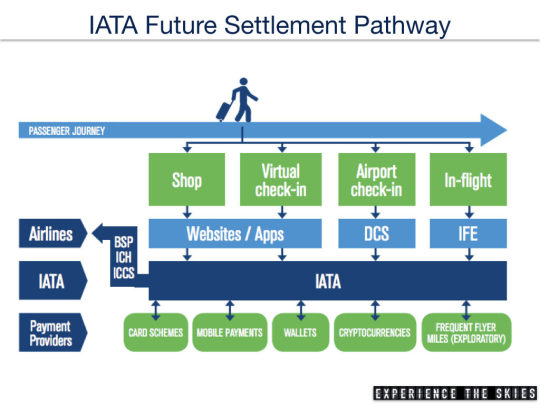
IATA Future Settlement Pathway (From IATA's Simplifying The Business White Paper 2016)
One Travel Record
With every new trip booking, a customer is given at least one but likely many confirmations from airlines, hotels, car rental companies, etc. Each record set up by suppliers does not necessarily interact with one another. As such, any disruptions in the travel journey would result in communication gaps and loss of service.
Example 1: a customer with an itinerary containing air and hotel components would be impacted when the airline does not communicate a cancellation to the hotel directly. The manual intervention required to change or cancel the hotel reservation would induce stress for the customer (uncertainty) and loss revenue for the hotel (inability to resell room while holding the reservation).
Example 2: a customer with an airline ticket containing two flights with separate airlines would be impacted with a misconnection due to an initial flight delay. It is highly possible that the second airline may not have quick access to the ticket to accommodate the onward journey when this happens. Depending on how integrated the airlines are, many steps and resources may be involved to transfer a ticket for processing and re-issuance.
With blockchain, airline and its partners would be able to create one record to handle the customer's entire itinerary. Each party (airline, airport, car rental, hotel, etc) involved would be notified of the journey's status at each milestone and would be able to make appropriate modifications as required in a timely manner.
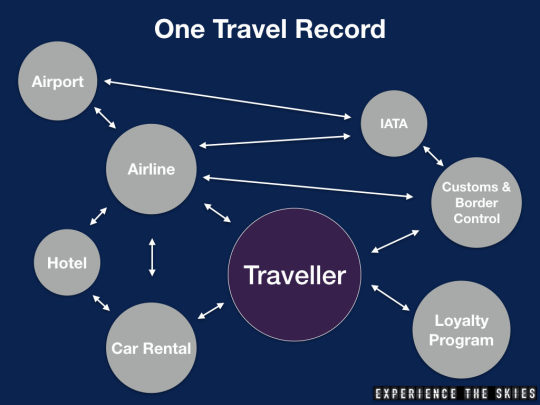
One Travel Record (Created by Experience The Skies)
The concept can be further extended to passenger security where traveller information is shared between different customs & border control agencies and IATA for vetting. Combining with use of biometrics can enhance travellers screening experience and improve operational throughput, response and reduce the number duplicate systems.
Marketing Opportunities
In a distributed ledger model, all participant companies with the right credential would gain access to a set of data to create metrics for used to improve operations and expand new marketing opportunities. The latter is important in:
evaluate current product lines for feedback, engagement and spend potential
extending personalization options to existing customers
expand customer base with new product lines
forming new partnerships not available previously
Future Is Unknown
The airline industry uses many legacy back office software to process transactions, create and update records. The companies (airlines, hotels, car rentals, etc) like to take ownership of all facets of the processing pipeline and are not as willing to share data with others. As such, adopting to newer cloud technology or participating in a distributed ledger model may require a significant change in culture and philosophy. It might take a company like Winding Tree (working with largely Lufthansa Group airlines) to realize and showcase the benefits of the technology before others will follow in drove. Fast adoption is not unexpected across the industry for another three years or more.
Additionally, the airline industry would have to invest in technology infrastructure and transform some of its business and IT functions to manage new requirements. This means airlines would have to invest in resources (systems and personnel) to plan, build and manage the paradigm shift.
Read the full article
0 notes
Text
Virgin Australia Will Be First To Implement Pop Up Check In Concept
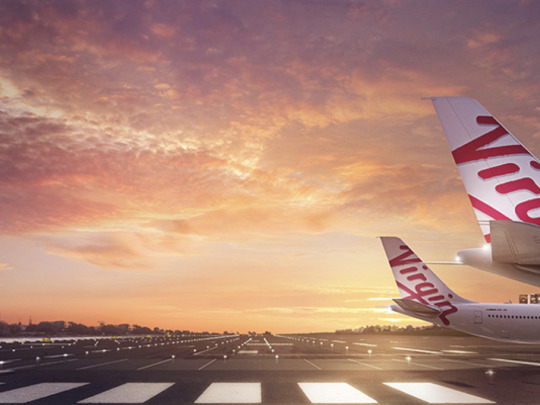
Virgin Australia hopes to become the first airline in the world to implement pop up check-in counters at different off-site locations across Australia to ease airport congestions and manage larger groups of passengers.
Virgin Australia
What Is It?
The Sydney based airline named the service "Off Airport Check-In Solutions (OACIS)" which makes use of Amadeus' Airport Common User Service cloud technology to allow passengers to check in, receive their boarding passes with seat allocation, purchase ancillary services and drop off baggages. The latter would be transferred directly by the airline's shipping partners to the correct flight.
https://youtu.be/JPFRvlW29R8
The new service will be trialed at Sydney's two major cruise ship docks: Overseas Passenger Terminal and White Bay Cruise Terminal at an unannounced date. These two locations are ideal to serve the trial as more than 300 cruises with over 500,000 passengers are operated out of the city annually.
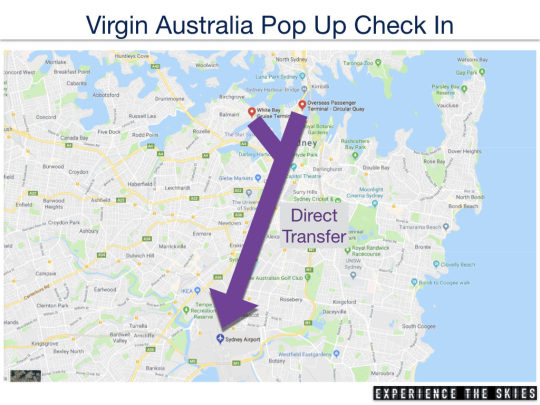
Virgin Australia Pop Up Check In Concept Trial (Map information supplied by Google)
Benefits For Customers
For customers with baggages, the new pop up concept would greatly reduce the anxiety from checking in at the airport. They would gain:
Less to carry around on the way to the airport. This is especially useful when travelling with many pieces of baggages.
More time to enjoy local offerings prior to departure to the airport.
More time to spend at airport lounges or use amenities (e.g. restaurants, spas, observation decks) prior to boarding.
Benefits for Virgin Australia
Virgin Australia would be able to manage a customer's journey earlier. This would allow the airline to:
Deploy an agile and flexible service as required to manage customer expectations. This is especially important when there is an airline service disruption (e.g. The airline can inform any delays to the customer sooner and provide appropriate compensation prior to airport arrival).
Manage its flight operations with more accurate real time information on customer loads and baggage information. The airline can track and load baggages sooner leading to less losses and compensations.
Engage the customer sooner with live travel information and ancillary product offers (i.e. lounge access, cabin upgrades, food upgrades, airport amenities and other priority service items, etc). All offers and purchases data can be collected to build a more personalization experience based on customer commonalities (e.g. class of service matching, offer success rates, and pricing, etc).
Offer new business opportunities with airline partners like Delta Air Lines by extending this service to their passengers on codeshared flights.
Benefits for the Airport Authority
The airport authority can use this new service to engage customers sooner with an appropriate array of service (e.g. spa treatment bookings) and product offerings (e.g. restaurant reservations, shopping tours, lounges). The key is to remind the customers that their journeys to one destination is not over until they board.
Competition and Similar Services
Australia
Virgin Australia's key rival Qantas Airways and its subsidiaries have not announced a similar service initiative as of February 2018.
Around the World
While the pop up check-in concept is new, early check-in facilities are available around the world. Here are some examples:
Airlines and airport authorities have been offering this service at major airport express train stations with Vienna (with Austrian Airlines only), Hong Kong, Kuala Lumpur and Bangkok serving as city examples.
Lufthansa partners with train operators to allow customers to purchase one ticket with an air/train combinations. This allow customers to check in earlier and drop off their baggages conveniently when arriving at Frankfurt Airport Station.
Customers staying at Disney Resorts can check in and drop off their baggages on site with Alaska Airlines, American Airlines, Delta Air Lines (U.S. Domestic Flights Only), jetBlue Airways, Southwest Airlines, and United Airlines as part of the Disney Magic Express service.
Future Use Cases
Based on the outcome of the trial, Virgin Australia can form new partnerships with airline partners, cruise lines, train operators, hotels and tour operators to build and operate these pop up check ins. This would improve the airline's non-aeronautical revenue from fees collected, additional service rendered and customer data sharing when used in conjunction within the block chain model (Refer to Blockchain And The Airline Industry - Part 1 for additional information).
Read the full article
#AlaskaAirlines#Amadeus#AmericanAirlines#DeltaAirLines#DisneyMagicExpress#JetBlueAirways#Lufthansa#SouthwestAirlines#UNITEDAIRLINES#VirginAustralia
0 notes
Text
Blockchain And The Airline Industry (Part 1)
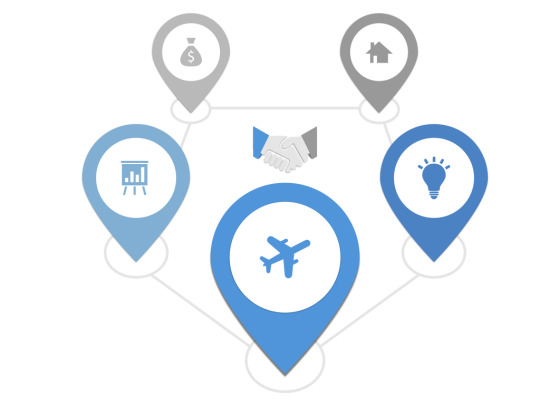
One of the biggest buzzwords for 2018 is blockchain. It was developed for use initially in digital currencies such as Bitcoins. The technology's robust security, transparency, and durability features lend itself into new business use cases. Experience The Skies introduces what the blockchain technology is and what the airline industry has done to embrace this new technology.
Blockchain
What Is It?
Created in 2008, a blockchain, originally called block chain, is a continuously expanding list of records, called "blocks". They are linked and secured together by using asymmetry cryptography techniques. Each block typically contains a cryptographic hash of the previous block, a timestamp and transaction data. It is by design that it is inherently resistant to modification of the data. A blockchain database is a digital ledger of transactions recorded.
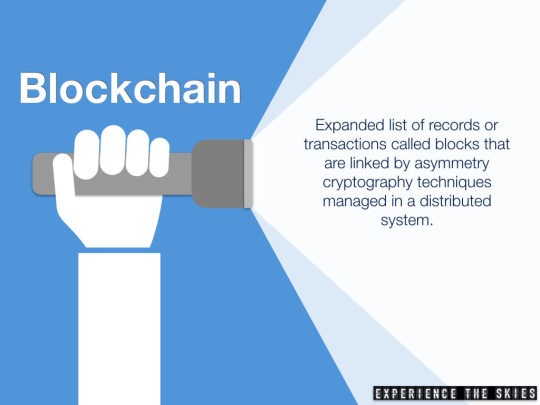
Blockchain Definition
Key characteristics of each blockchain database:
Ownership - Cannot be controlled by a single source / entity as it is managed autonomously by a peer to peer network in a decentralized manner.
Creation / Modification - Records/transactions can be updated automatically (smart contract) when they occur and cannot be retroactively modified. This creates a digital audit trail for all modifications.
Authentication / Identity Management - All participants are identified and authenticated with their own digital token before they can create or modify records/transactions. This reduces fraudulent participants and transaction creation.
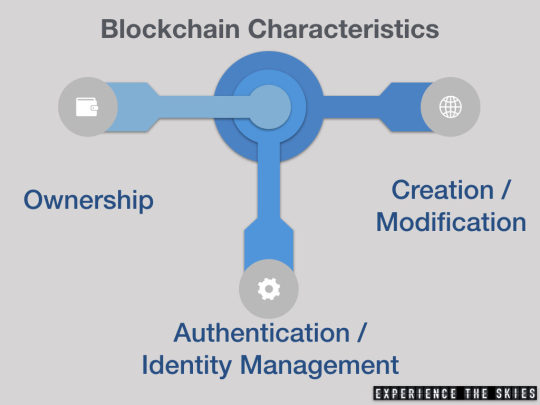
Blockchain Main Characteristics
The Airline Connection
The travel industry has not embraced blockchain like banking, healthcare or government. While its future is unknown, there are some early supporters including Emirates, Lufthansa, Singapore Airlines.
Emirates - President Sir Tim Clark, was noted recently with Business Insider that, "Blockchain is a revolution within a revolution." It is not about how the technology would displace jobs but how it would need to the construction on new application and use cased beyond cryptocurrencies. "It's going to transform everything we do and how you and I interact with each other and things around us, " he added.
Lufthansa Industry Solutions initiated Blockchain for Aviation (BC4A) with the goal to "bring together all fields of expertise and to collectively sound out the potentials of blockchain technology. Potential participants include, for instance, software developers, aircraft manufacturers, MRO service providers, logistics providers, lessors and regulators." A potential use case may be storage of relevant safety documentations for training, review and auditing across different agencies. This will ensure that the information is updated and available to all parties involved, reduce overhead of storing/updating multiple copies and improving response time on inquiries.
Singapore Airlines aims to be the world's first airline to use blockchain technology within its frequent flyer program, KrisFlyer ®. It is partnering with Microsoft and KPMG Digital Village to develop a new KrisFlyer digital wallet mobile application that would allow members to purchase products and services at participating merchants in Singapore.
“Innovation has been a key contributor to the success of Singapore Airlines since Day 1 and we are very excited about this world-first initiative, which will bring even more benefits to members of our KrisFlyer programme,” said Singapore Airlines CEO Goh Choon Phong. “This groundbreaking development in which we will be using blockchain technology to ‘digitalise’ KrisFlyer miles is a demonstration of the investment we are making to significantly enhance the digital side of our business for the benefit of our customers. It is in line with our recently unveiled Digital Innovation Blueprint, under which we aim to be the world’s leading digital airline.”
Winding Tree, a "blockchain-based decentralized open-source travel distribution platform" that aims to make travel cheaper for end users and lowering costs for airlines by cutting out intermediaries within the B2B environment. It is partnering with six Star Alliance member airlines (Lufthansa, Austrian Airlines, Air New Zealand, SWISS Air Lines International, Brussel Airlines and Eurowings) currently to trial and experiment with more seamless automated settlement process. Outside of settlements, the company is exploring other use cases.
https://youtu.be/_qer1qd68eQ
Future Is Unknown
The airline industry uses many legacy back office software to process transactions, create and update records. The companies (airlines, hotels, car rentals, etc) like to take ownership of all facets of the processing pipeline and are not as willing to share data with others. As such, adopting to newer cloud technology or participating in a distributed ledger model may require a significant change in culture and philosophy. It might take a company like Winding Tree (working with largely Lufthansa Group airlines) to realize and showcase the benefits of the technology before others will follow in drove. Fast adoption is not unexpected across the industry for another three years or more.
Additionally, the airline industry would have to invest in technology infrastructure and transform some of its business and IT functions to manage new requirements. This means airlines would have to invest in resources (systems and personnel) to plan, build and manage the paradigm shift.
Read the full article
0 notes
Text
2018 Trend - Free Messaging On Board North American Edition
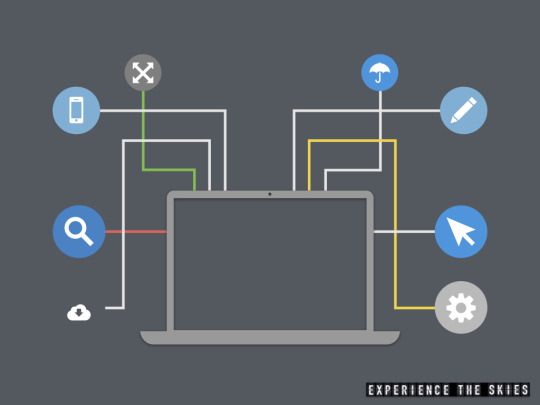
Over the past five years, the biggest North American airlines installed Wi-Fi improve connectivity. Most of them charges for internet access with the exception of JetBlue Airways which provides complimentary access for their passengers. In 2018, a new trend is brewing as airlines expands or introduces free messaging on board. Experience The Skies reveals which North American airlines are participating in this trend currently and where it will head next.
Messaging - What Is it?
Messaging (also called electronic messaging) is the creation, storage, exchange, and management of text, images, voice, telex, fax , e-mail, paging, and Electronic Data Interchange (EDI) over a communications network. Over the past three years, standalone messaging applications took over the lead from traditional telecom managed Short Message Service (SMS) as the most popular method of communication between users around the world.
The most popular standalone messaging applications by daily active users in the world are: WhatsApp, Facebook Messenger, WeChat, Line and Viber. The first two applications owned by Facebook Inc., are also the most popular in North America. When it comes to hybrid messaging / SMS tools, Apple's iMessage and Android's Hangout/Allo are the most popular when factoring their high user bases.
In a Pew Research Center piece on social media engagement, it is noted that more than 55% of smartphone users in its survey uses some form of messaging applications with eMarketer contributing separately that number of minutes/day spent on them vs total mobile app time will increase dramatically through 2018 and beyond.

Mobile Messaging Engagement Courtesy of eMarketer
The Airline Connection
Airlines progressively look for new ways to engage and provide a better on board customer experience as air traffic picks up. In 2018, this means including free messaging to passengers travelling on selective Wi-Fi equipped flights. All they need to do is to necessary messaging apps downloaded ahead of time, start a Wi-Fi connection once the flight is above a certain threshold (typically 10,000 feet) and start communicating. The only drawback is that messages will only support words and emojis. Sending pictures, videos or other contents may not be supported at start.
As for February 2018, the following North American airlines provide or have announced free messaging (iMessage, Facebook Messenger and WhatsApp) to customers travelling on board Wi-Fi equipped flights within the domestic 50 US states and parts of Canada.
Alaska Airlines
American Airlines (to be implemented sometime in 2018)
Delta Air Lines
JetBlue Airways (the New York based airline provide free Wi-Fi internet service)
Virgin America
While not completely free, Southwest Airlines' customers can use iMessage, Viber and WhatsApp for US$2 per day.
Future Trends
2018 is the year airlines provide some form of internet access to an extended set of customers. Within a competitive domestic market, access to free messaging on board may sway potential customers in choosing one airline over another if price, route and timing are the same or similar. This competitive advantage is stronger on longer flights where external communication is appreciated or required.
In addition, free messaging may just be the tip of the iceberg in expanding complete internet access to all customers. RouteHappy reported recently that there are 82 airlines worldwide with Wi-Fi equipped aircrafts in their fleet. Unfortunately, less than 10% of them are providing free internet access.
Similar to airports and hotel chains within the last ten years, internet access went from the additional pay per user model to free when costs were managed. Here are a list of options airlines can consider to reduce costs of service:

Spectrum of Access
Introduce an ads based tier (limited access). It is important for airlines to vet these ads and make them relevant to the travel experience or risk negative feedbacks.
Provide a lower speed/capacity tier for all customers similar to the concept created by hotel chains currently. Additional ancillary revenue can be made by selling one time or subscription access to higher speed / capacity service based on customers needs (full access)
Reward loyal frequent customers and those flying in premium cabins or at a higher fare. The costs can be covered as part of marketing, imbedded cabin service costs or loyalty program (unlimited access).
Partnerships
Airlines do not have to be responsible for the entire cost of providing free messaging or internet access to its customers. They can explore partnership arrangements with relevant parties for subsidies or sponsorships. The following are three examples of partnerships for consideration:
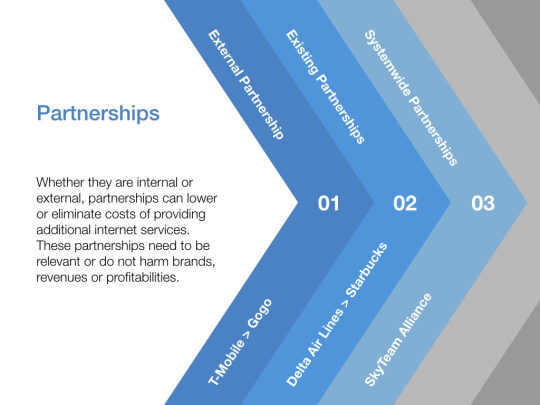
Partnerships
Selective T-Mobile mobile subscribers have access to 1 hr or unlimited use of internet on board Gogo equipped flights. Airlines would not have to pay for data used but would have maintain availability (external partnerships).
An airline such as Delta Air Lines can approach its worldwide coffee supplier, Starbucks, to subsidize costs as the latter already provides free internet access at many of its coffeehouse worldwide. In exchange, both can expand their co-brand marketing efforts, the airline can provide unoccupied real estate spaces for Starbucks products and both can enhance customer intelligence (existing partnerships).
Airline alliances such as SkyTeam may also explore purchasing internet bandwidth and capacity on behalf of all its members in bulk to obtain lower pricing per unit (systemwide partnerships).
Read the full article
#AlaskaAirlines#AmericanAirlines#DeltaAirLines#Gogo#JetBlueAirways#Messaging#SkyTeam#SouthwestAirlines#Starbucks#VirginAmerica
0 notes
Text
New Google Flights Functions Inform Customers About Basic Economy Fares
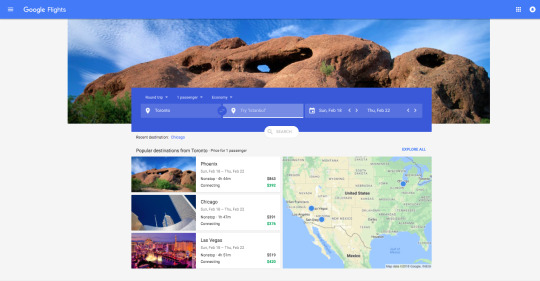
There have been a lot of customer confusion on basic economy fares since Delta Air Lines, United Airlines and American Airlines introduced them in their route network in the last five years. The confusion stems from the different amenities available for these customers by each of these airlines. For example, Delta Air Lines allows them to bring on a full size carryon baggage and use the overhead bin on board while United Airlines and American Airlines do not. In an attempt to ease confusion, online flight search tool Google Flights has incorporated the amenities included for this fare type in its latest beta release. We look at how this new function works, what is good about it and what Google can do to further improve the customer experience in design and capacities.
Google Flights
How It Works
Google Flights is an online tool that allows customers to search for fares based on specific set of criteria including date of travel, origin/destinations, cabin of service, and number of segments. This has not changed in the new beta release.
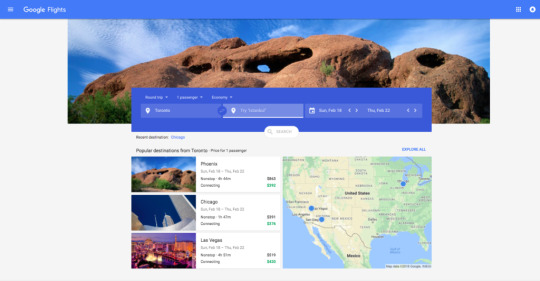
Opening Screen - Courtesy of Google Flights
The tool searches for all available fares based on the customer criteria including those from airlines directly or other online travel retailers such as Expedia, Orbitz, and Priceline.
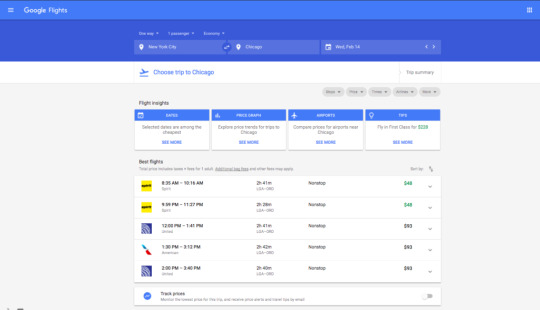
Search results (NYC to CHI on Feb 14, 2018) courtesy of Google Flights
Based on the listing (sorted by price by default), customers can select a flight to get more detail information. Besides the typical price, flight times, airport locations, seat pitch, wi-fi and entertainment options, Google Flights has added new information (highlighted by red boxes) on whether the fare is the Basic Economy variety and noted any carry-on baggage restriction in addition to baggage information for the fare at the bottom.

Fare selection detail view courtesy of Google Flights
Clicking the Basic Economy pull down menu would reveal other restrictions for this fare and how much it would cost to get some of these amenities with a higher fare (in this example, it would cost an additional US$24 to obtain use of overhead bin (which implies that customer can bring a full size carryon baggage on board) and to choose a seat in the economy cabin in advance. Once the customer picks the correct fare, pressing the SELECT button will transfer to the airline's website for booking completion and confirmation (Note that airlines may ask the customer to confirm the lack of amenities available in a basic economy fare before proceeding).
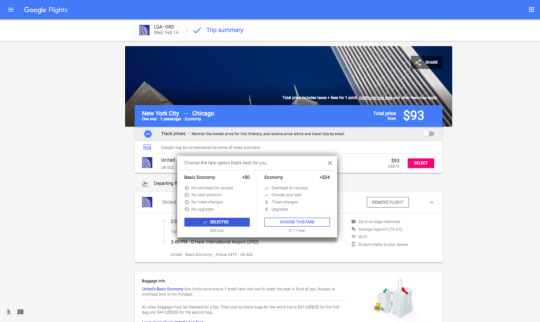
Basic economy restrictions courtesy of Google Flights
What Is Good About This Release?
Following other online travel retailers and fare aggregators like Expedia and Kayak, this new beta release provides customers with more information to make an informed decision on what tickets to buy.
As basic economy fares are not the same across different airlines, a pull down menu showing the available amenities help educate frequent and leisure travellers alike
Giving customers an option to choose another fare with more amenities saves time.
How Can Google Improve?
Following is a list of items that can further improve the customer experience when managing basic economy fares:
Add option to filter out Basic Economy fares for those who would always wait to select seats in advance or use the overhead bin
Include Basic Economy fares (e.g. with a symbol or a word) to highlight them at the initial search results. To promote fairness, this should include all fares (such as the one shown for Sprit Airlines) which have the similar basic economy type restrictions.
In the detail view, Basic Economy should be highlighted with a different color or typeface to draw would be customers' attention.
Google Flights should integrate further with Google Assistant to allow voice command searches on basic economy fares and definition
Read the full article
0 notes
Text
Air Transat Fined For Stranding Passengers In Ottawa
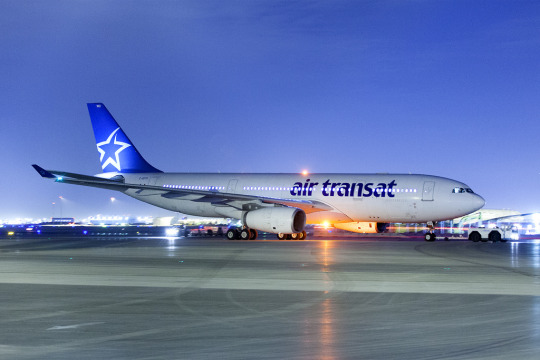
The Canadian Transportation Agency (CTA) has ruled that Air Transat (TS) broke its agreement with passengers when it left them stranded on two aircrafts on the tarmac of the Ottawa International Airport (YOW)a on July 31, 2007. The airline was fined CDN$295,000 and ordered to compensate passengers for any out-of-pocket expenses related to the flight delays.
Air Transat
What Happened?'
Air Transat is a Canadian aircraft based in Montreal. The airline operates scheduled and chartered flights to leisure markets in North America and Europe. Two separate Air Transat flights destined to Montreal's Pierre Trudeau International Airport (YUL) from Rome's Leonardo da Vinci–Fiumicino Airport (FCO) and Brussels Airport (BRU) were diverted to Ottawa due to weather. CTA agreed that this diversion was out of the airline's controls. What happened after the aircrafts landed was the subject of an extensive inquiry.
Once landed, passengers on the Brussels and Rome flights were stranded inside the aircrafts for six and four hours each without food, drinks or the the opportunity to disembark. One flight's air conditioning also broke down during the ordeal. The supply of food/drinks and the opportunity to disembark is part of the Air Transat's tariff. The latter is specifically considered after the aircraft has been grounded for 90 minutes and if the captain decides it is safe to do so.
During the incident, the airline reported that there were insufficient resources (i.e refuelling information, staircase, etc) available from the airport to allow for disembarkment while the airport stated that there were no separate requests by Air Transat to offload passengers.
After the inquiry was completed, the CTA ruled that the airline had the full responsibility to ensure that its tariff is enacted and worked with the airport authority to manage passenger needs once the aircrafts were grounded. The airline acknowledged this ruling and provided additional compensations to passengers on the affected flights.

Statement on Delayed Flights (Tweet from Air Transat)
Additional Changed Ordered
The CTA also ordered Air Transat to make changes to its procedures to ensure similar incidents will not occur again. These procedures include:
Train all employees involved in offering services during onboard delays about the legal obligations under its tariff.
Amend its tariff to include a requirement to update passengers every 30 minutes and deplane passengers after four hours of delay if it is safe by Feb. 27, 2018.
Provide a stricter definition of events that release it from contractual obligations.
Passenger Bill Of Rights
The Canadian federal government has been working on a passenger bill of rights as part of Bill C-49 - Transportation Modernization Act. First reported by Experience The Skies in May 2017, this act introduced specific criteria for inclusion in airlines' tariffs to manage such items as voluntary or involuntary denied boarding (“bumping”), delays, cancellations, passenger re-routing, and lost or damaged baggage.
At a minimum, all Canadian air carriers must:
Set tariff terms and conditions that respect certain legal requirements, are reasonable and fair, and applied the same way for everyone, as much as possible;
Clearly display the tariff at their offices and on their websites; and
Apply the terms and conditions of carriage as stated in their tariff.
As of December 1, 2017, this bill is in the second reading at the Senate and is expected to pass by 2018.
How Can Airlines Do Better?
In the age of social media and real time reporting, airlines and airports face more scrutiny when there are disruptions. This may have reputational and financial impacts to the parties involved. Airlines can manage passenger expectations better by proactively engaging with airport authorities to build processes in handling disruptions at all airports that it serves.
The processes should include the following key items:
Assessment of tariffs and how they should be handled in different disruptive scenarios
Communication and training on relevant procedures by staff
Timely testing of these procedures as part of onboarding or annual training requirements
Monitoring and feedback mechanism for the airline to set goals on beginning a better passenger experience
Third party tests by independent sources to verify that the procedures work as intended (e.g. simulate a disruption or perform a drill by working with the airport authorities)
In addition, the airline should introduce a communication protocol (online, telephone, direct communication on board) to provide passengers with timely and relevant information on any form of disruption. Bad news is better than no news especially when passengers are faced with unknowns and heightened anxiety. Proactively handling disruptions, delays and cancellations can generate goodwill for the airline.
Read the full article
0 notes
Text
IAG's LEVEL Adds A New Base And New Destinations in 2018
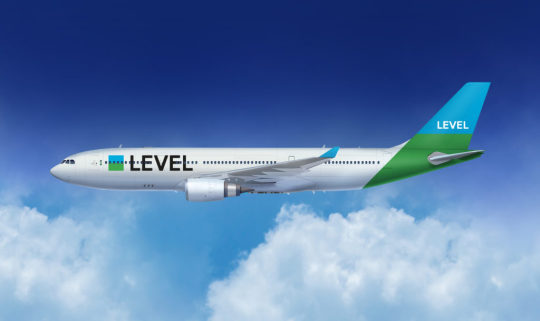
LEVEL is a low cost carrier (News - Low Cost Carrier LEVEL Starts Operations) set up by International Airlines Group (IAG) to handle long haul operations out of Europe and compete with the likes Joon (News - Air France Unveiled New Low Cost Carrier Named Joon), WOW Air and Norwegian Air Shuttle (News - Norwegian Controls Low Cost Transatlantic Flights).
LEVEL
In operation since June 1, 2017, the Barcelona based airline served four destinations to start with attractive prices.

LEVEL introductory pricing to four destinations (Image courtesy of the airline)
As discussed in IAG's third quarter 2017 investor call, IAG's Head of Group Strategy & Development, Alistair Hartley spoke of the initial success of LEVEL. The airline went on sale in March 2017 and promptly sold more than 50,000 tickets within the first 24 hours and recorded load factors that exceeded 90% on some flights. Adding to the targeted 10-20% cost efficiency, LEVEL is expected to deliver more to IAG's bottom line while serving as the anchor of the company's dual brands strategy (i.e. full service brand with British Airways and Iberia, low cost brand with LEVEL).

IAG's Dual Brand Strategy (Information taken from Capital Markets Day Presentation / November 3, 2017)
Future Growth
In a previous Insight, Experience The Skies predicted that LEVEL should consider expanding to destinations like Boston, Montreal, Las Vegas, New York Newark, etc. On November 28, 2017, the airline announced it will expand in 2018 with a new base in Paris Orly with operation to four new airports to start. Its original Barcelona base will also add another destination to the mix.
https://www.youtube.com/watch?v=BeD73heUEpU
Paris Orly Airport
Paris Orly Airport (ORY) is located 13 km or 8.1 mi south of Paris and is the smaller of the two Parisian airports with international transatlantic flights. LEVEL will introduce flights to the following four destinations in 2018:
Martinique Aimé Césaire International Airport (FDF) (Fort-de-France, Martinique) - begins 4 September 2018
Montréal–Trudeau International Airport (YUL) (Montreal, Canada) - begins 2 July 2018
Newark Liberty International Airport (EWR) (Newark, USA) - begins 4 September 2018
Pointe-à-Pitre International Airport (PTP) (Guadeloupe, France) - begins 3 July 2018

LEVEL's destinations from Paris Orly Airport (Information provided by the airline)
In other news, IAG's subsidiary - OpenSkies, will cease operations from Paris Orly in July 2018 around the same time as LEVEL's introduction at the airport. OpenSkies flies under the British Airways livery with flights from Paris Orly to New York JFK and Newark currently. It was set up in 2009 as a merger with L'avion with the goal for British Airways to build a secondary gateway for transatlantic flights away from London Heathrow Airport (LHR). Without many passenger feeds, the carrier is not highly successful.
Barcelona El-Prat Airport
LEVEL will add a fifth destination to its main base at Barcelona El-Prat Airport (BCN). The new Boston Logan International Airport (BOS) flight will begin on March 28, 2018.
All flights will continue to be operated with Airbus A330-200 aircrafts equipped with 314 seats in a two class configuration (21 premium economy and 293 economy).
Read the full article
#Barcelona#Barcelona El-Prat Airport#Boston#IAG#International Airlines Group#LEVEL#Montréal#Newark#Paris#Paris-Orly Airport
0 notes